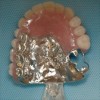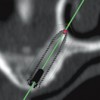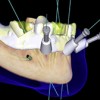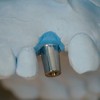Record bases and wax rims are used for recording the postural position of the mandible in relation to the maxilla so that we can arrange the denture teeth in their correct occlusal relationship. Properly contoured wax rims are used as aid in developing proper contour of the lips and cheeks, developing the plane of occlusion and determining the proper position of the incisal edges of the maxillary anterior teeth. This program provides detailed illustrations and descriptions regarding the fabrication of these useful aids.
Complete Dentures»
- 1. 9. Record Base and Wax Rim Fabrication Michael Hamada, DDS and John Beumer III, DDS, MS Division of Advanced Prosthodontics, Biomaterials and Hospital Dentistry UCLA School of Dentistry This program of instruction is protected by copyright ©. No portion of this program of instruction may be reproduced, recorded or transferred by any means electronic, digital, photographic, mechanical etc., or by any information storage or retrieval system, without prior permission.
- 2. 8. Boxing Impressions and Making Casts John Beumer III, DDS, MS and Robert Duell, DDS Division of Advanced Prosthodontics, Biomaterials and Hospital Dentistry UCLA School of Dentistry This program of instruction is protected by copyright ©. No portion of this program of instruction may be reproduced, recorded or transferred by any means electronic, digital, photographic, mechanical etc., or by any information storage or retrieval system, without prior permission.
- 3. Record Base – An interim denture base
- Used to support wax rims
- 4. Record Base – An interim denture base
- Used for making centric relation records
- 5. Record Base – An interim denture base
- Used in making trial dentures
- 6. Characteristics of an Ideal Record Base
- Strength and rigidity
- Accuracy
- The record base should not rock on the cast
- Smooth, rounded well polished borders
- Thickness of borders and palate must resemble those of the finished dentures
- Palate must be 1-2 mm thick
- Thickness and contour of the denture borders are defined by the land of the master cast. The record base must not extend onto the land of the cast
- 7. Materials Used for Record Bases
- Tray resin
- Brittle but very accurate
- Autopolymerizing acrylic resin
- Strong but less accurate
- Light cure resin
- Accurate but brittle and expensive
- 8. Fabrication of Record Bases and Wax Rims
- Separating medium
- Baseplate wax
- Wax spatula
- Hanau torch
- Hot plate
- Cloth polishing wheel
- Large camel’s hair brush
- Red handle knife
- Celluloid mm rule
- Bunsen burner
- Autopolymerizing acrylic resin
Instruments and Materials
- 9. Procedures*
- Blocking out the Master Casts*
- Undercuts
- Frenum areas
- Rugai
- Irregular surfaces
- Redundant tissue areas
- Mark areas of block out with a red pencil
- Flow a thin layer of wax over the outlined areas with baseplate wax
- 10. Procedures
- Blocking out the master casts
- Block out frenum and other irregularities
- Wax should be thin enough to see through
- 11. Procedures
- Blocked out master casts coated with Alcote tin-foil substitute
- 12. Maxillary Record Base Fabrication
- Sprinkle-on technique of resin addition
- 13. Maxillary Record Base Fabrication
- Build up labial flange by alternating polymer and monomer addition
- 14. Maxillary Record Base Fabrication
- Sprinkle on a thin consistent layer over the palate
- 15. Maxillary Record Base Fabrication
- Reinforce the ridge crest to prevent slumping
- Keep the surface moist with monomer to prevent porosity
- Keep ridge lap areas thin to facilitate tooth placement
- 16. Mandibular Record Base Fabrication
- Manipulate the cast to prevent slumping
- Build up the flanges
- 17. Mandibular Record Base Fabrication
- Reinforce the lingual portion of the flange and ridge crest
- 18. Record Base Polymerization
- Process acrylic resin in Pressure Pot
- 20 psi
- 110 degrees water
- 10 to 15 minutes
- In absence of a pressure pot, place casts under an over-turned rubber mixing bowl
- 19. Record Base Preparation
- Soak the polymerized record base and casts in hot water to soften the block-out wax
- Then, gently pry the record bases from the master cast
- 20. Record Base Preparation
- Gently remove all block-out wax from master cast without damaging surface
- Remove wax which may prevent seating of record base from tissue surface
- 21. Record Base Preparation Maxilla Areas requiring modification on unfinished record bases Land Flash
- 22. Record Base Preparation – Maxilla
- Trim excess flash
- 23. Trim the excess acrylic resin that extends onto the land of the cast (flash) as shown here . Note: The only portion of the record base that is highly polished is the periphery. Record Base Preparation – Mandible
- 24. Record Base Preparation
- Thin ridge lap portion of denture base
Ridge Lap portion must be thin enough to accommodate the anterior teeth
- 25. Record Base Contouring/Finishing
- Palate should be consistent 1-2mm thick to facilitate speech. Thick record bases may also precipitate gagging.
- Pumice the oral (tongue) side of the palate and flanges for patient comfort
- 26. Thick maxillary record bases and convex contours of mandibular record bases impinge upon the tongue space and prevent the patient from articulating speech sounds in a normal fashion . Result – vertical dimension of occlusion and centric relation records made from such record bases may be inaccurate. The “s” sound is particularly useful when determining the vertical dimension of occlusion Patient in the “S” position
- 27. Completed Record Bases Checklist
- Palate should be consistent 1-2 mm thick and well adapted
- Lingual of ridge of mandible reinforced but concave
- Retromolar pad area covered
- Thin areas labial to ridge
- Roughened ridge areas
- 28. Completed Record Bases Checklist
- No porosity or voids on tissue surface
- Flanges smooth and rounded
- Tissue surfaces well adapted
- 29. Completed Record Bases Checklist
- No excess flash on land area of master casts
- Record bases do not rock on master casts and are reasonably retentive
- 30. Wax Occlusion Rims – Purpose
- Serve as a means of transfer of face bow transfer records
- Aid in orientation of the incisors and the occlusal plane when properly contoured
- Aid in developing contours of the lips and cheek when properly contoured
- Used in developing the vertical dimension of occlusion
- Used in making tentative centric relation records
- Serve as a general aid in selection of teeth
- 31. Instruments and Materials
- Baseplate wax
- Kingsly scraper
- Wax spatula
- Occlusal plane former (hot plate )
- 32.
- Place maxillary record base on the cast.
- Heat a sheet of baseplate wax in the Bunsen burner until the wax is very pliable.
- Roll the wax into long tube.
- Starting at the tuberosity, press the roll of wax against the crest of the ridge.
- Seal the wax to the record base with a hot wax spatula. If necessary, fill in the voids with additional wax.
Technical Procedures
- 33. f) Heat the occlusal plane former in a flame and carefully form the occlusal aspect of the rim. Catch the melted wax in a paper towel. g) Form the buccal and labial contours with the hot plate in a similar manner. If there are voids fill them with wax and repeat the process. Technical Procedures
- 34. Maxillary Wax Rim Check List
- The occlusal portion of the rim should have the following thickness
- a) Molar region – 8 mm
- b) Premolar region – 6 mm
- c) Anterior region – 3 mm
- As viewed from the lateral perspective the rim should project anteriorly to just beyond the outer edge of the land of the cast.
- Lingual contours must not impinge on the tongue space.
Anterior region Posterior region
- 35. Maxillary Wax Rim Check List
- The labial and lingual surfaces must be smooth and free of voids
- The posterior section of the rim should be tapered to avoid the retromolar pad
- The curvature of the anterior portion must simulate the curvature of the edentulous arch
- 36. The mandibular wax rim is fabricated in a similar manner, however, the rim should be centered over the crest of the ridge. Lingual contours must not impinge on the tongue space. Mandibular Wax Rim
- 37. Completed Wax Rims
- 38. a. Face Bow Transfer Record The face bow bite fork is attached to the wax rim and this apparatus is positioned intra-orally. The face bow apparatus is attached and appropriately adjusted and transferred to the articulator, permitting proper mounting of the maxillary cast on the upper member of the articulator .
- 39. a. Facebow Transfer Record
- The mounting is carefully smoothed and sanded. When you are finished all your mountings must look like this one.
- 40. b. Determine Incisor Position and Occlusal Plane Record base and wax rim is placed into position and a “Fox” occlusal plane can be used to verify the proper level and angulation of the occlusal plane. If the wax rim does not conform to the landmarks indicating the proper plane of occlusion (Camper’s plane) the was rim is altered until it does conform.
- 41.
- When the wax rim is ideally contoured and mounted and the lower cast mounted on the on the articulator with a centric relation record, the plane of occlusion is readily seen.
- The three determinants of the occlusal plane are readily seen:
- The incisal edge of the central incisor
- The middle third of the retromolar pads bilaterally
b. Determine Incisor Position and Occlusal Plane
- 42. c . Aid in developing contour of the lips and cheeks . Wax rim is contoured with the rim former until the desired lip and cheek contours are developed
- 43. d. Determine the Proper Vertical Dimension of Occlusion The wax rims aid the clinician in determining the proper vertical dimension of occlusion.
- 44. Wax rims are used as an aid to determine the proper vertical dimension of occlusion and making centric relation records and transferring them to the articulator. e. Used to Make Centric Relation Records
- 45.
- e . Used to Make Centric Relation Records
“ VDR” “ VDO ” VDO = The length of the face when the teeth are in contact and the mandible or the teeth are in centric relation
- 46.
- f. Serves as a General Aid in Tooth Selection
The position of the corners of the mouth are marked on the wax rims and the distance between these two marks can serve as a guide to tooth selection.
- 47. A wax rim properly contoured in the anterior region (arrows) aids in positioning the anterior teeth. Anterior maxillary teeth are arranged according to the labial contours developed in the patient. f. Maxillary Record Base and Wax Rim


 Implants and RPDs
Implants and RPDs
 Prosthodontic Procedures and Complications
Prosthodontic Procedures and Complications
 Computer Guided Treatment Planning and Surgery
Computer Guided Treatment Planning and Surgery
 Cement Retention vs Screw Retention
Cement Retention vs Screw Retention
